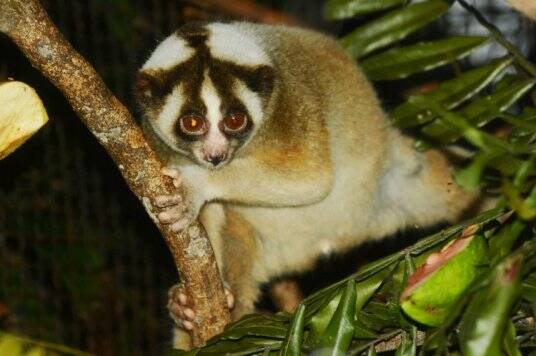Nycticebus javanicus
IUCN
LCBasic Information
Scientific classification
- name:Nycticebus javanicus
- Scientific Name:Nycticebus javanicus,Javan Slow Loris
- Outline:Primates
- Family:S.loris
Vital signs
- length:About 29 cm
- Weight:565-687g
- lifetime:No verification information
Feature
There is a distinct stripe covering the top of the head and branching towards the eyes and ears
Distribution and Habitat
It is found only in the province of Banten in the west of Java, Indonesia, and also in the west of East Java, Indonesia. It inhabits primary and secondary forests, bamboo forests and mangroves, and cocoa plantations. The altitude is from sea level to 2,300 meters.
Appearance
The Javan slow loris weighs between 565-687 grams, has a muzzle length of 19.9 mm, a head width of 43.6 mm, a body width of 250.8 mm, a head-body length of 293.1 mm, a chest circumference of 190.8 mm, a neck circumference of 136.7 mm, a tail length of 20.4 mm, a humerus length of 67.2 mm, a radius length of 71.8 mm, a femur length of 83.2 mm, a tibia length of 85.9 mm, a hand span of 59.1 mm, a foot span of 70.3 mm, and an ear length of 16.8 mm. It is similar in appearance to the largest slow loris, the Bengal slow loris. It has a distinct stripe on its face and back that covers the top of the head and forks towards the eyes and ears, leaving a white diamond pattern on the forehead. Its fur color is yellow-grey, with a cream color on the head, neck, and shoulders. Like the Philippine slow loris, it lacks a second incisor in its dentition.
The morphological distinction of Ornatus is its longer hair, which averages 26.8 mm, while the hair of Nominate is 22.4 mm. Other distinguishing f
Details
Javan Slow Loris (scientific name: Nycticebus javanicus) is also known as Javan Slow Loris. It has two subspecies.

The Javan slow loris is nocturnal and arboreal, rarely going to the ground. It spends its activities, foraging, mating, reproduction and hibernation in trees. During the day, it curls up in a ball and hides in the tree holes of tall trees, near the lush canopy of branches and leaves, or on the forks of dense branches to rest. It starts to move around and forage after dusk. They like to move alone, move very slowly, mostly climbing, and do not jump. They only speed up when attacked. They are slow and deliberate climbers, often holding on to branches with three of their limbs. To move between trees, they carefully grasp the terminal branches of nearby trees and pull themselves through small gaps. They will also hold branches with only their hind feet, lift themselves up, and quickly pounce forward with their hands to eat.
Javan slow loris are omnivorous animals, and their food includes tropical fresh flowers, leaves and berries, insectivorous and other arthropods, small birds and reptiles, eggs, fruits, gums, nectar and other vegetation. They usually forage alone all night. They are good at preying on sleeping birds at night and like to eat bird eggs and honey.
Listed in the IUCN Red List of Threatened Species in 2015 ver3.1 - Critically Endangered (CR).
Protect wild animals and eliminate game.
Maintaining ecological balance is everyone's responsibility!








